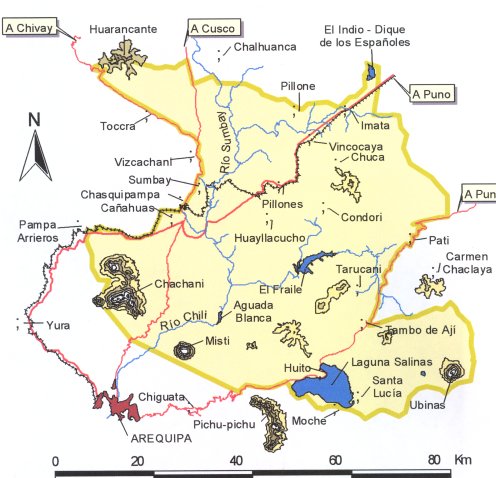Peru designates two high altitude wetlands

The Ramsar Bureau is delighted to announce that the Government of Peru has named two High Andean wetlands in Arequipa for the List of Wetlands of International Importance, effective 28 October 2003, bringing that Party's total to 10 Ramsar sites covering 6,777,547 hectares.
As described by Ramsar's Iván Darío Valencia based on the Ramsar Information Sheets, Bofedales y Laguna de Salinas (17,657 ha., 16º22´S 71º08W) is a salt high Andean lake in the Puna at 4,300m altitude, lying at the bottom of an endorrheic basin with geothermal activities amidst snow-capped mountains and volcanoes. Open peat bogs known as bofedales surround the lake, providing an important grazing area for native camelids such as vicuñas and llamas as well as habitat for the endemic pupfish Orestias agassizii. Chilean (Phoenicopterus chilensis), James's (Phoenicoparrus jamesi), and the endangered Andean flamingoes  (Phoenicoparrus andinus) inhabit the lake, reaching over 20,000 during the rainy season. Calidris spp sandpipers also winter in large numbers. Salt and borate mining is an important economic activity in the lake itself but also the main concern for the site due to the necessary soil removal of its operations. The impacts of overgrazing, the traditional activities of picking duck's eggs, and trout culture are being addressed through a Management Plan of the Salinas and Aguada Blanca National Reserve {right}, to which the Ramsar site belongs.
(Phoenicoparrus andinus) inhabit the lake, reaching over 20,000 during the rainy season. Calidris spp sandpipers also winter in large numbers. Salt and borate mining is an important economic activity in the lake itself but also the main concern for the site due to the necessary soil removal of its operations. The impacts of overgrazing, the traditional activities of picking duck's eggs, and trout culture are being addressed through a Management Plan of the Salinas and Aguada Blanca National Reserve {right}, to which the Ramsar site belongs.
Laguna del Indio - Dique de los Españoles (502 ha., 15º46´S 71º03'W) is a natural high Andean seasonal pool at over 4440m in the Puna which became permanent with the building of a reservoir serving the water needs of the city of Arequipa and which is used for hydroelectric power generation downstream. Sharp water level fluctuations in the reservoir allow for peat bog plants such as Distichia muchoides to prosper on its shores. The Andean Goose Chloephaga melanoptera, which nests in peat bogs and grasses, and the Andean Duck Oxyura ferruginea have significant populations in the lake, while Wilson's Phalarope Phalaropus tricolor and the Crested Duck Anas specularioides are also relatively numerous. The endangered vicuña is frequent in the surroundings, where local people also raise llamas and alpacas. Other human activities are trout fishing in the reservoir and egg picking from geese and ducks. The remnants of a colonial dyke used for irrigation are found in the site. The area is part of the National Reserve of Salinas and Aguada Blanca, for which a management plan was established in 2001.